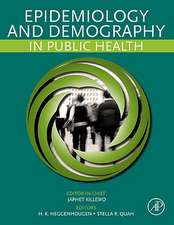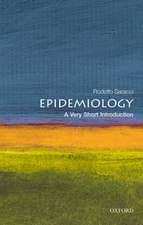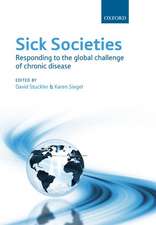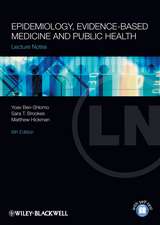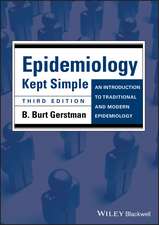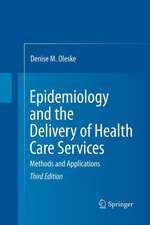Statistical Methods for Disease Clustering: Statistics for Biology and Health
Autor Toshiro Tangoen Limba Engleză Paperback – 3 mai 2012
| Toate formatele și edițiile | Preț | Express |
|---|---|---|
| Paperback (1) | 695.01 lei 6-8 săpt. | |
| Springer – 3 mai 2012 | 695.01 lei 6-8 săpt. | |
| Hardback (1) | 701.25 lei 6-8 săpt. | |
| Springer – feb 2010 | 701.25 lei 6-8 săpt. |
Din seria Statistics for Biology and Health
- 20%
 Preț: 633.23 lei
Preț: 633.23 lei - 17%
 Preț: 352.01 lei
Preț: 352.01 lei - 20%
 Preț: 758.04 lei
Preț: 758.04 lei - 20%
 Preț: 1379.34 lei
Preț: 1379.34 lei - 18%
 Preț: 1394.84 lei
Preț: 1394.84 lei - 18%
 Preț: 883.59 lei
Preț: 883.59 lei - 5%
 Preț: 843.91 lei
Preț: 843.91 lei -
 Preț: 397.16 lei
Preț: 397.16 lei - 20%
 Preț: 1002.67 lei
Preț: 1002.67 lei - 18%
 Preț: 1395.32 lei
Preț: 1395.32 lei - 5%
 Preț: 1102.10 lei
Preț: 1102.10 lei - 5%
 Preț: 874.83 lei
Preț: 874.83 lei - 15%
 Preț: 657.39 lei
Preț: 657.39 lei - 18%
 Preț: 960.93 lei
Preț: 960.93 lei - 15%
 Preț: 585.90 lei
Preț: 585.90 lei - 5%
 Preț: 852.69 lei
Preț: 852.69 lei - 18%
 Preț: 903.62 lei
Preț: 903.62 lei - 5%
 Preț: 721.40 lei
Preț: 721.40 lei - 15%
 Preț: 653.46 lei
Preț: 653.46 lei - 18%
 Preț: 2114.90 lei
Preț: 2114.90 lei - 18%
 Preț: 1108.99 lei
Preț: 1108.99 lei - 5%
 Preț: 821.39 lei
Preț: 821.39 lei - 5%
 Preț: 849.02 lei
Preț: 849.02 lei - 15%
 Preț: 653.14 lei
Preț: 653.14 lei - 18%
 Preț: 958.56 lei
Preț: 958.56 lei - 5%
 Preț: 722.69 lei
Preț: 722.69 lei - 18%
 Preț: 728.74 lei
Preț: 728.74 lei - 18%
 Preț: 943.22 lei
Preț: 943.22 lei - 5%
 Preț: 1092.43 lei
Preț: 1092.43 lei - 15%
 Preț: 594.21 lei
Preț: 594.21 lei - 5%
 Preț: 377.87 lei
Preț: 377.87 lei - 18%
 Preț: 1124.60 lei
Preț: 1124.60 lei - 18%
 Preț: 1220.12 lei
Preț: 1220.12 lei - 15%
 Preț: 632.98 lei
Preț: 632.98 lei - 18%
 Preț: 1394.84 lei
Preț: 1394.84 lei -
 Preț: 389.11 lei
Preț: 389.11 lei - 18%
 Preț: 959.98 lei
Preț: 959.98 lei
Preț: 695.01 lei
Preț vechi: 817.66 lei
-15% Nou
Puncte Express: 1043
Preț estimativ în valută:
132.99€ • 139.20$ • 110.69£
132.99€ • 139.20$ • 110.69£
Carte tipărită la comandă
Livrare economică 01-15 aprilie
Preluare comenzi: 021 569.72.76
Specificații
ISBN-13: 9781461425564
ISBN-10: 1461425565
Pagini: 260
Ilustrații: VIII, 240 p.
Dimensiuni: 155 x 235 x 14 mm
Greutate: 0.37 kg
Ediția:2010
Editura: Springer
Colecția Springer
Seria Statistics for Biology and Health
Locul publicării:New York, NY, United States
ISBN-10: 1461425565
Pagini: 260
Ilustrații: VIII, 240 p.
Dimensiuni: 155 x 235 x 14 mm
Greutate: 0.37 kg
Ediția:2010
Editura: Springer
Colecția Springer
Seria Statistics for Biology and Health
Locul publicării:New York, NY, United States
Public țintă
ResearchCuprins
Clustering and Clusters.- Disease Mapping: Visualization of Spatial Clustering.- Tests for Temporal Clustering.- General Tests for Spatial Clustering: Regional Count Data.- General Tests for Spatial Clustering : Case-Control Point Data.- Tests for Space-Time Clustering.- Focused Tests for Spatial Clustering.- Space-Time Scan Statistics.
Recenzii
From the reviews:
“There is an increasing awareness nowadays of environmental health risks, including bioterrorism, together with the development of modern data collection systems. This combination provides a major impetus for the sorts of studies described in this book. … Overall, the book is very practically oriented. … The explanations of the methods are very clear and detailed and the discussion is informative. … the book will be of good use to the novice coming into the subject and also for the initiated wishing to broaden their perspective.” (Martin Crowder, International Statistical Review, Vol. 79 (2), 2011)
“The first introductory chapter informs the reader about the basic classification of disease clustering (temporal clustering, spatial clustering, and space–time clustering), the data used in examples, and software (like R, SaTScan, FleXScan, Splancs). … The suitable audience are experts’ communities either in the medical field or in the mathematical modeling field with the focus on data mining and clustering.” (Adriana Hornikova, Technometrics, Vol. 53 (2), May, 2011)
“There is an increasing awareness nowadays of environmental health risks, including bioterrorism, together with the development of modern data collection systems. This combination provides a major impetus for the sorts of studies described in this book. … Overall, the book is very practically oriented. … The explanations of the methods are very clear and detailed and the discussion is informative. … the book will be of good use to the novice coming into the subject and also for the initiated wishing to broaden their perspective.” (Martin Crowder, International Statistical Review, Vol. 79 (2), 2011)
“The first introductory chapter informs the reader about the basic classification of disease clustering (temporal clustering, spatial clustering, and space–time clustering), the data used in examples, and software (like R, SaTScan, FleXScan, Splancs). … The suitable audience are experts’ communities either in the medical field or in the mathematical modeling field with the focus on data mining and clustering.” (Adriana Hornikova, Technometrics, Vol. 53 (2), May, 2011)
Textul de pe ultima copertă
The development of powerful computing environment and the geographical information system (GIS) in recent decades has thrust the analysis of geo-referenced disease incidence data into the mainstream of spatial epidemiology. This book offers a modern perspective on statistical methods for detecting disease clustering, an indispensable procedure to find a statistical evidence on aetiology of the disease under study.
With increasing public health concerns about environmental risks, the need for sophisticated methods for analyzing spatial health events is immediate. Furthermore, the research area of statistical methods for disease clustering now attracts a wide audience due to the perceived need to implement wide-ranging monitoring systems to detect possible health-related events such as the occurrence of the severe acute respiratory syndrome (SARS), pandemic influenza and bioterrorism
As an invaluable resource for a wide range of audience including public health researchers, epidemiologists and biostatistians, this book features:
With increasing public health concerns about environmental risks, the need for sophisticated methods for analyzing spatial health events is immediate. Furthermore, the research area of statistical methods for disease clustering now attracts a wide audience due to the perceived need to implement wide-ranging monitoring systems to detect possible health-related events such as the occurrence of the severe acute respiratory syndrome (SARS), pandemic influenza and bioterrorism
As an invaluable resource for a wide range of audience including public health researchers, epidemiologists and biostatistians, this book features:
- A concise introduction to basic concepts of disease clustering/clusters
- A historical overview of methods for disease clustering
- A detailed treatment of selected methods useful for practical investigation of disease clustering
- Analysis and illustration of methods for a variety of real data sets
Caracteristici
Historical overview of methods for disease clustering Detailed treatment of selected methods useful for practical investigation of disease clustering Analysis and illustration of methods for a variety of real data sets Includes supplementary material: sn.pub/extras

